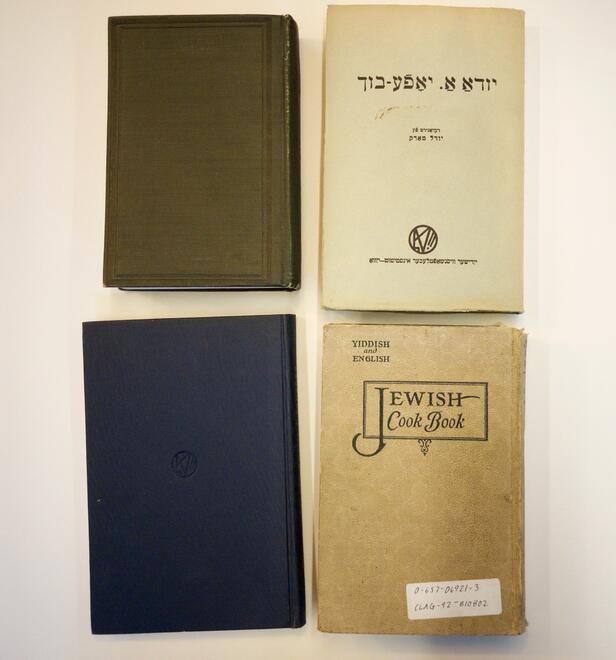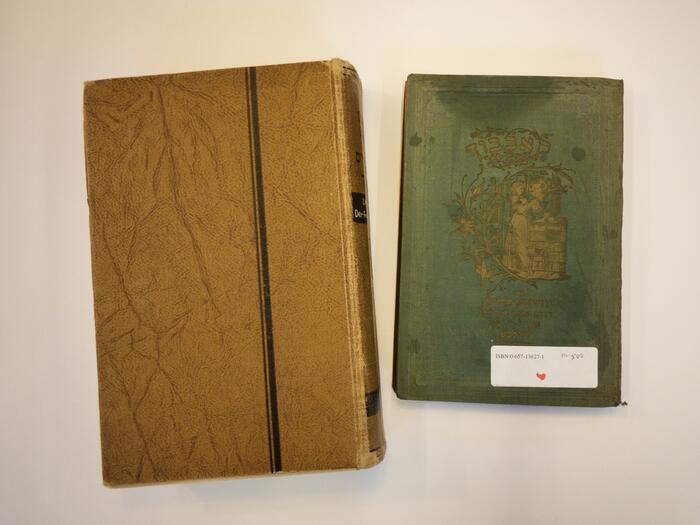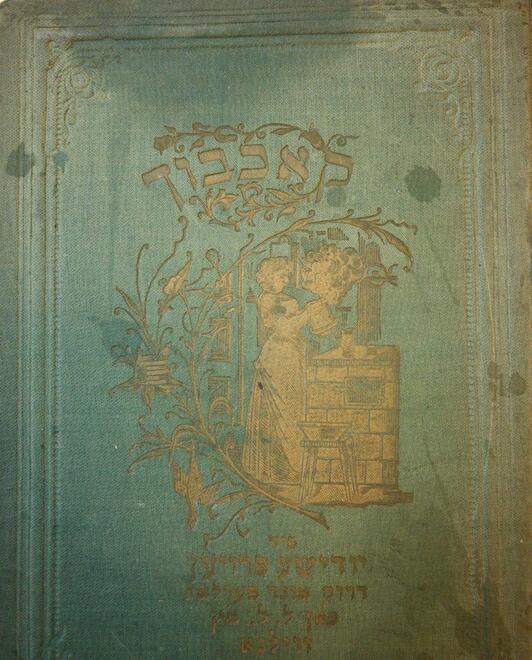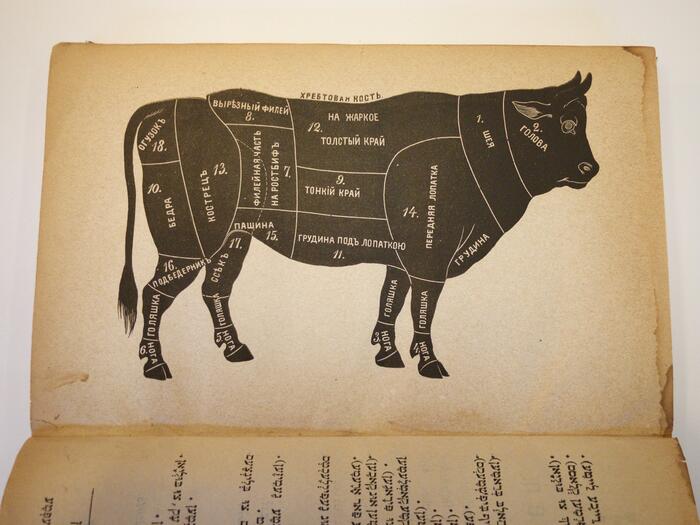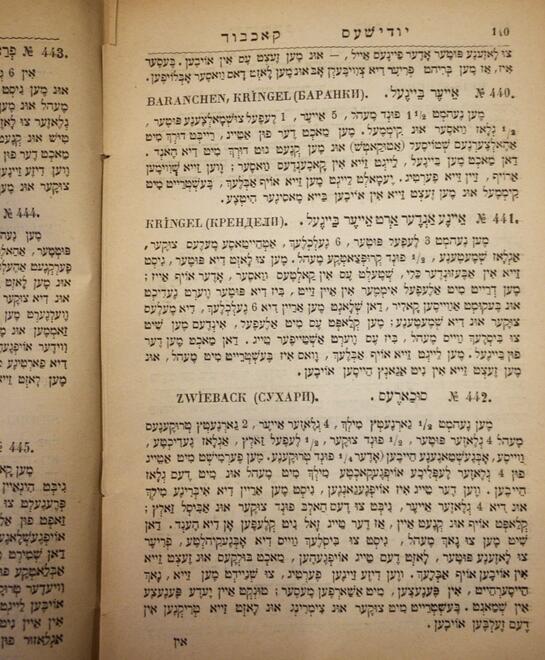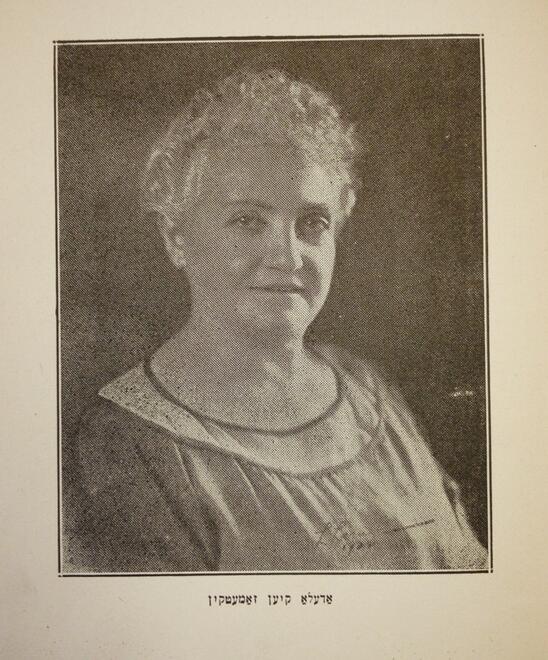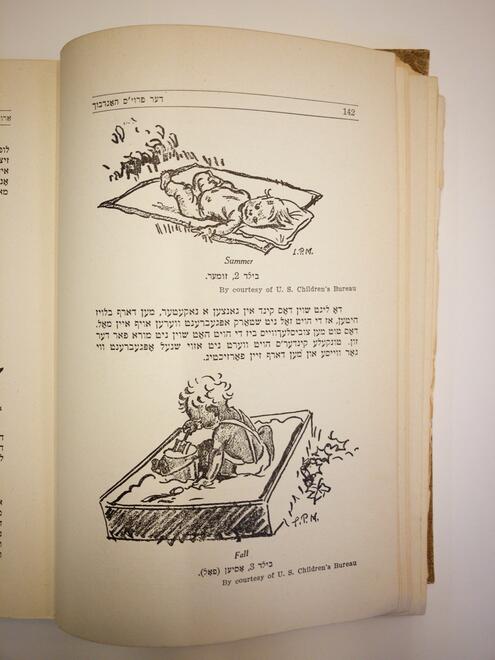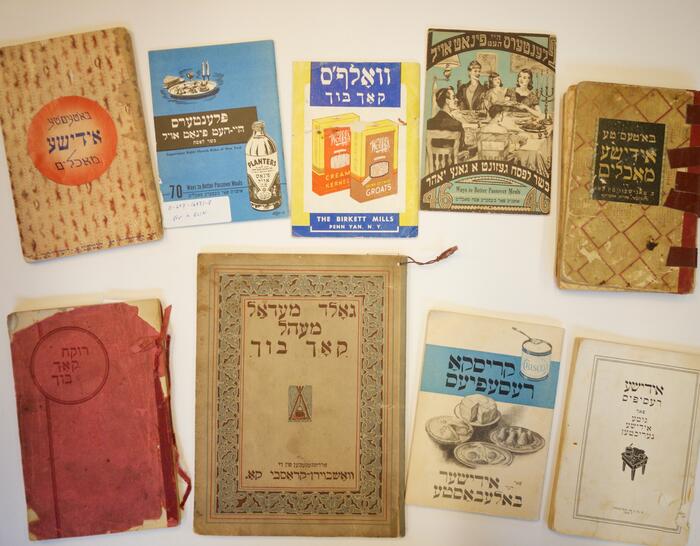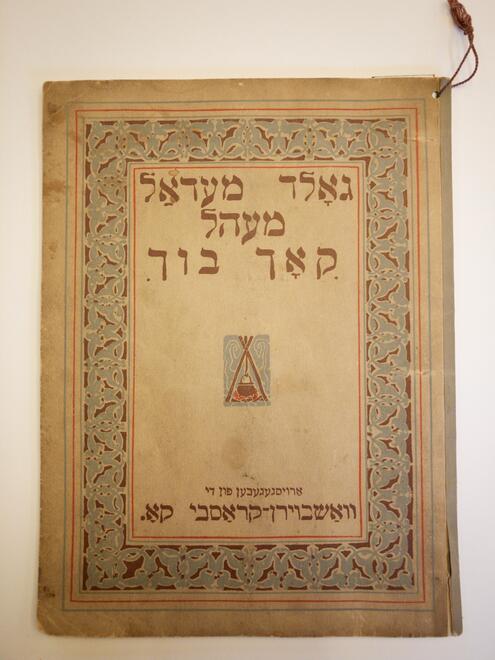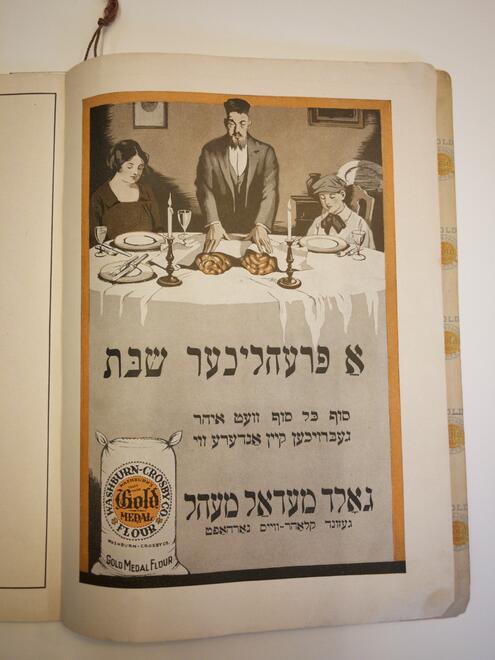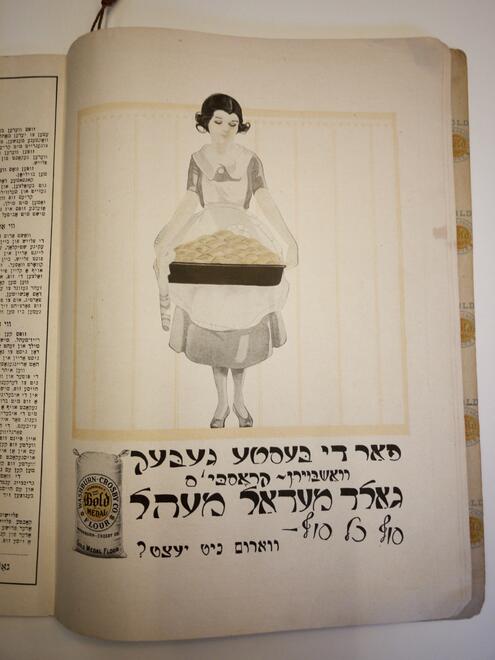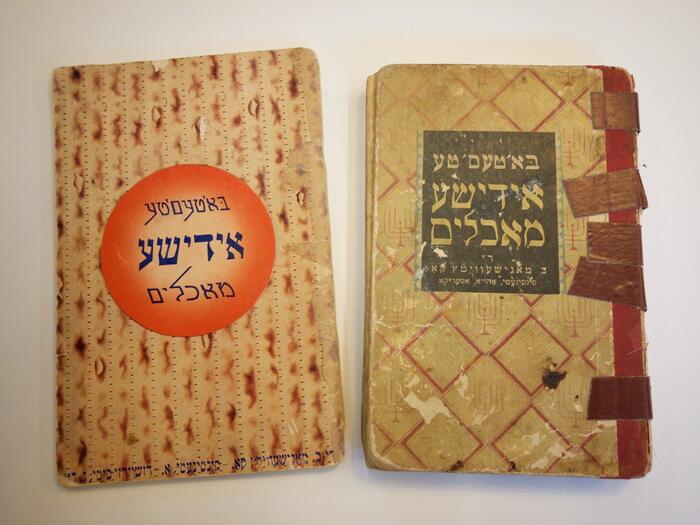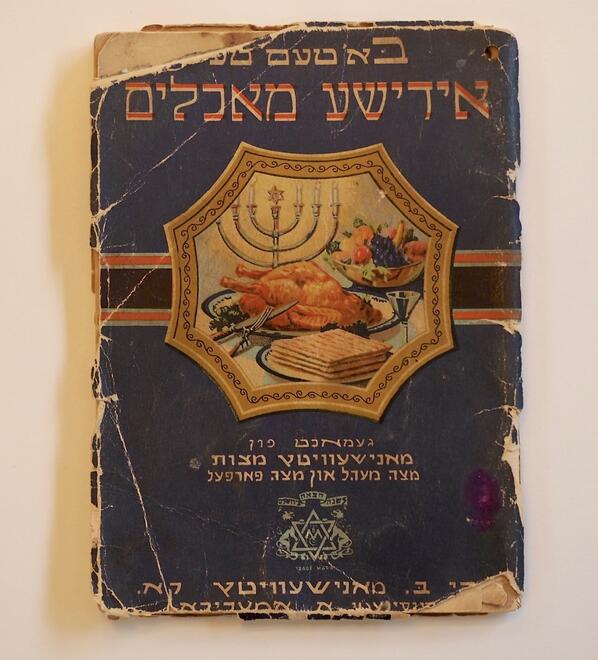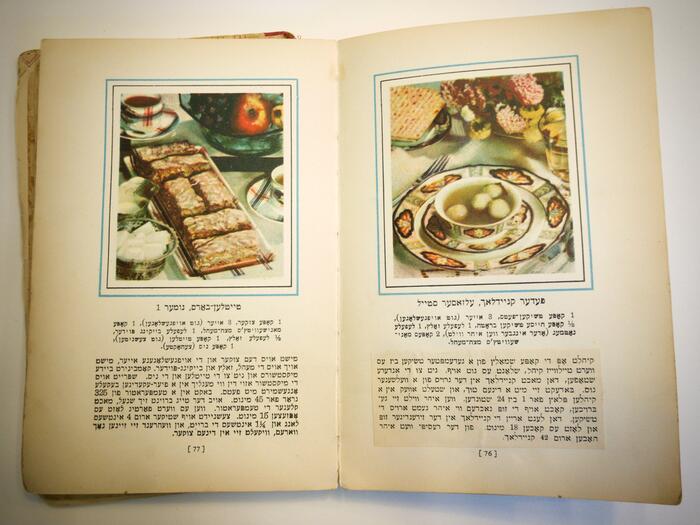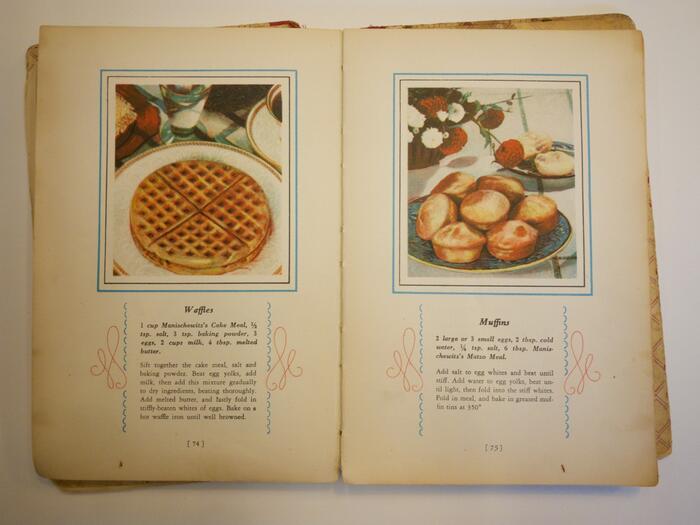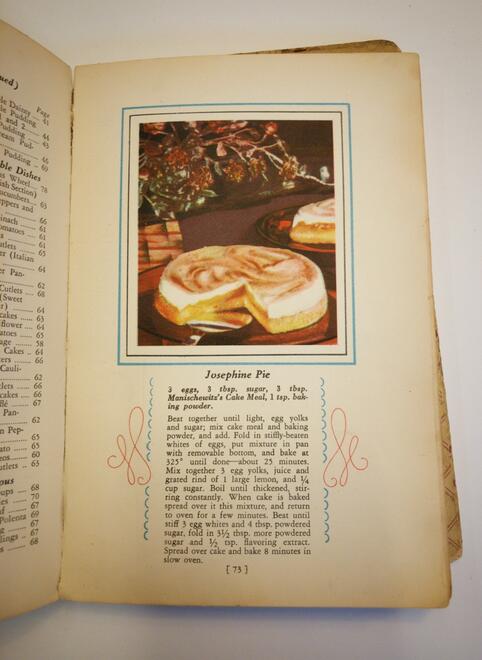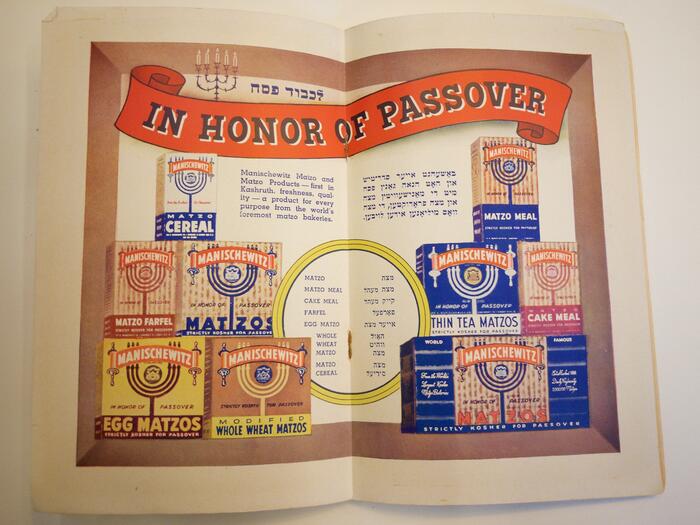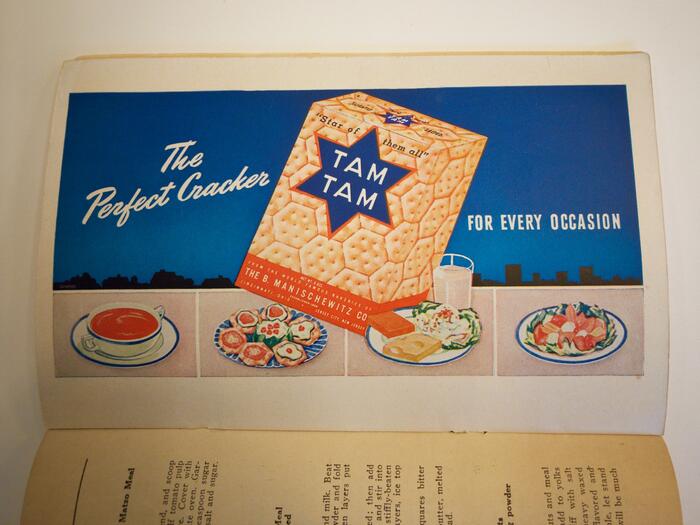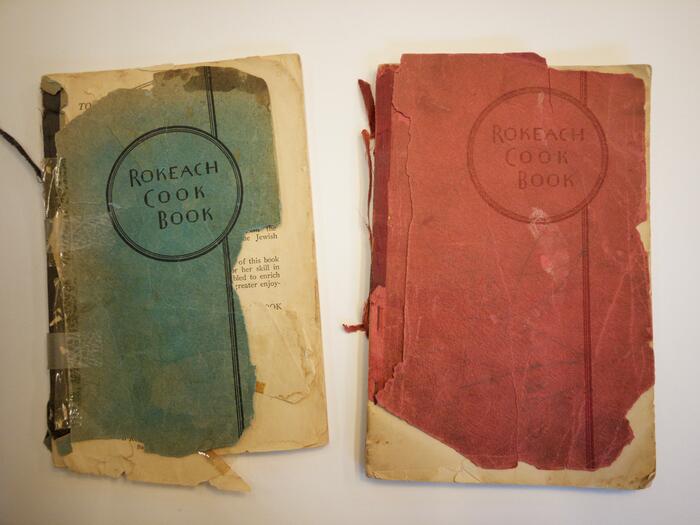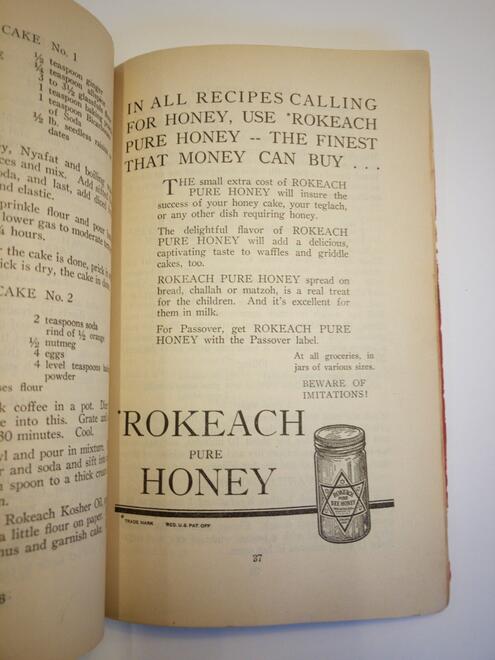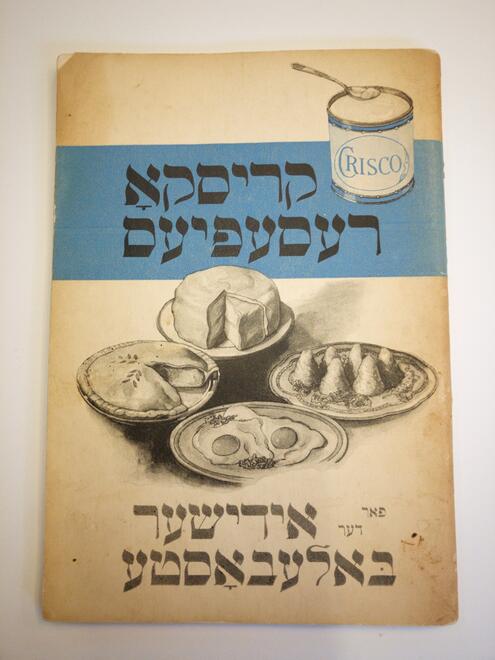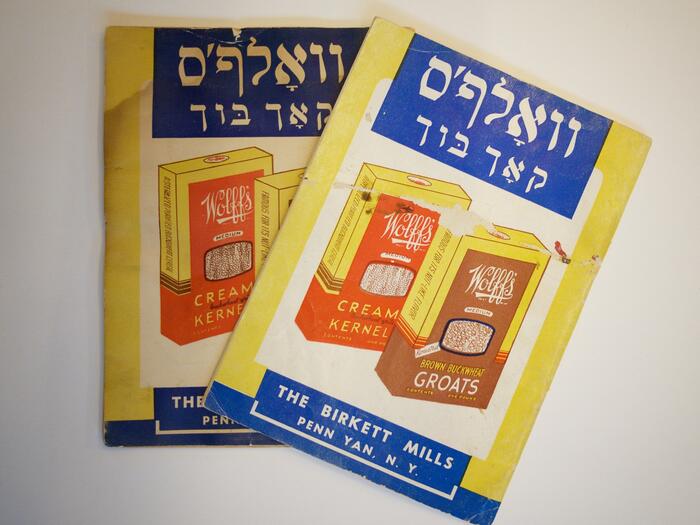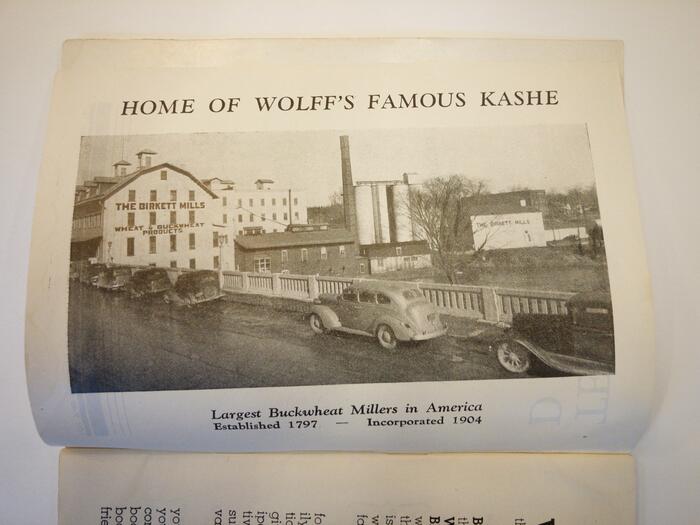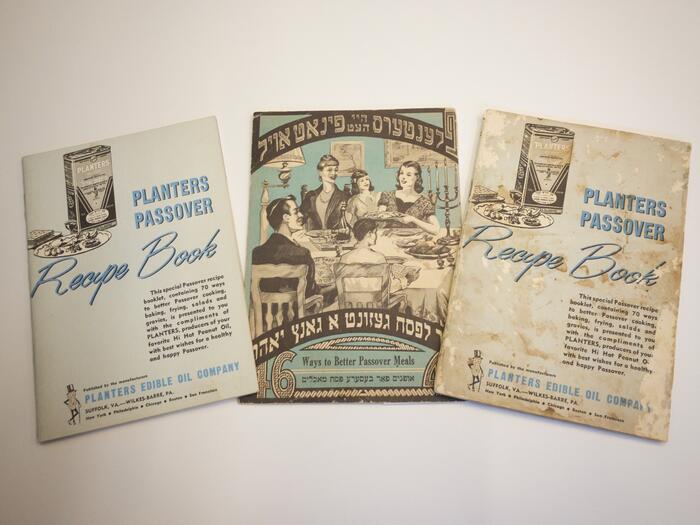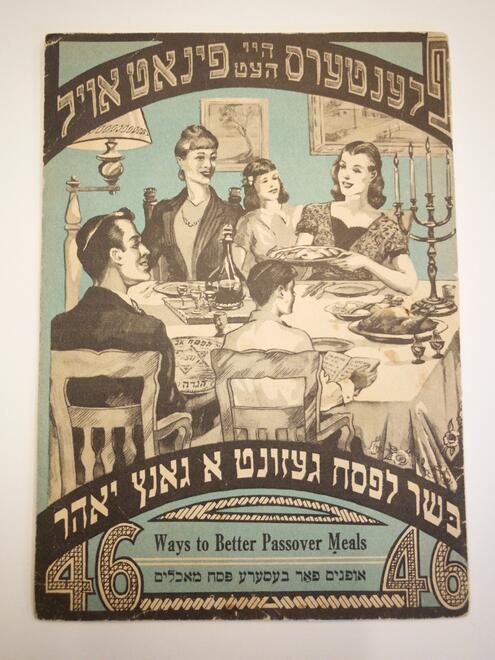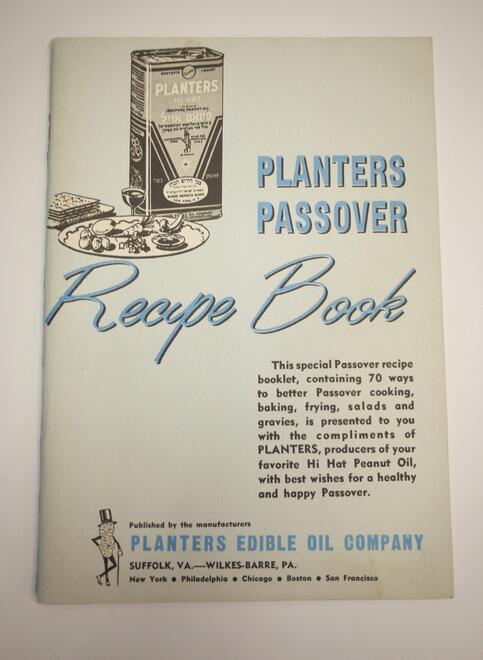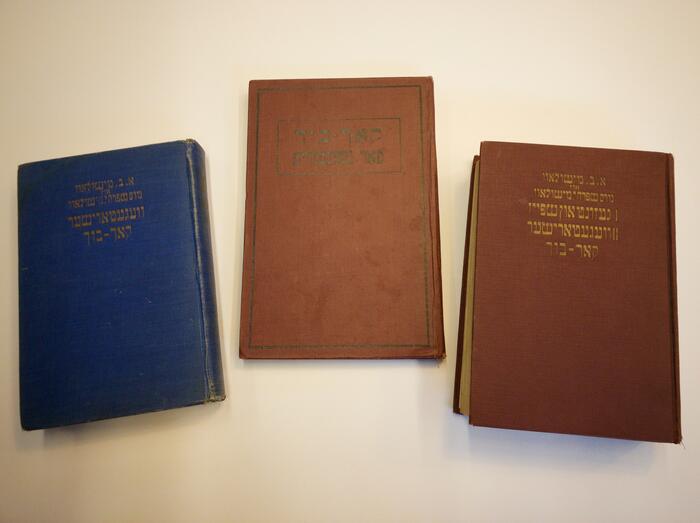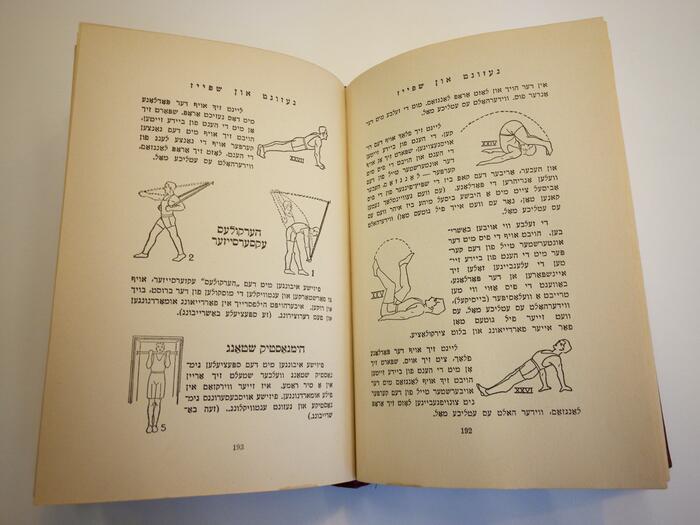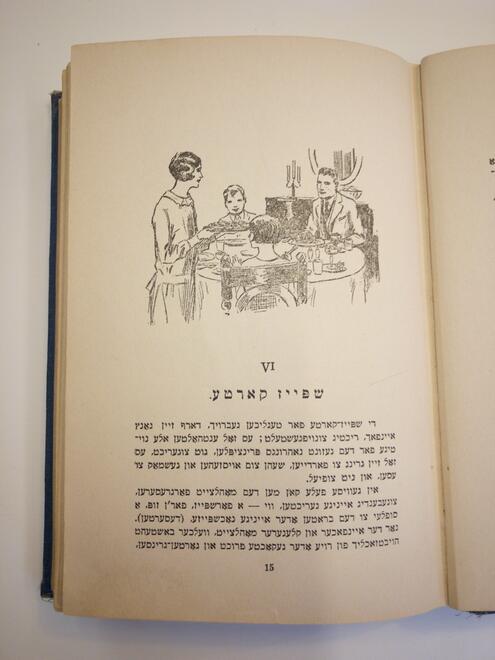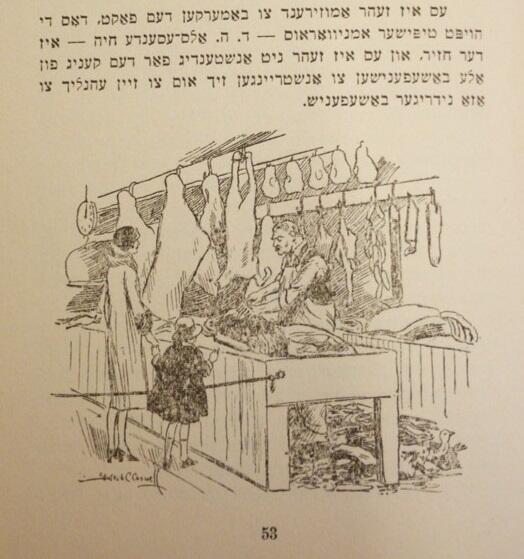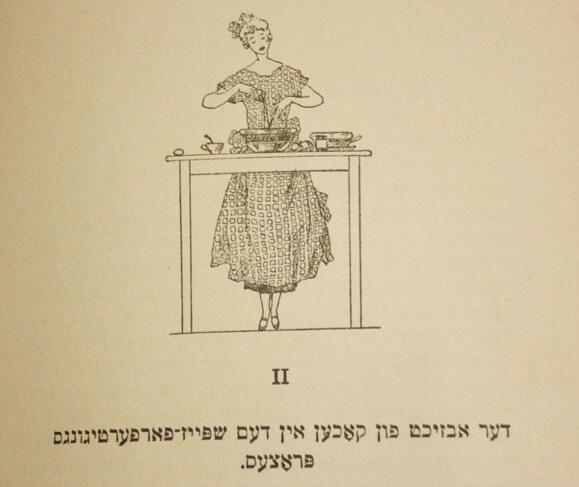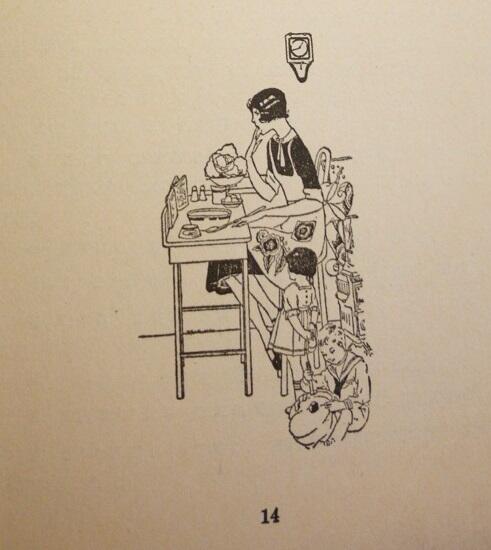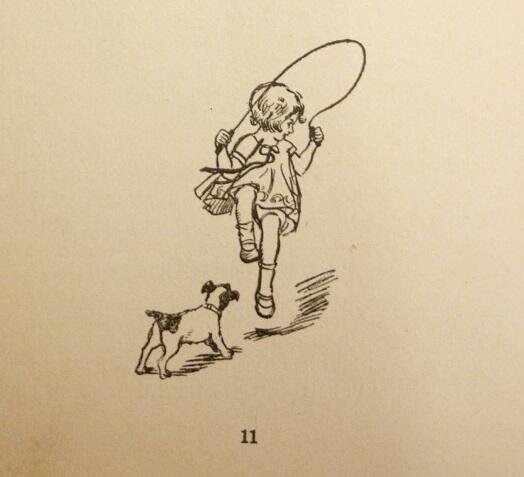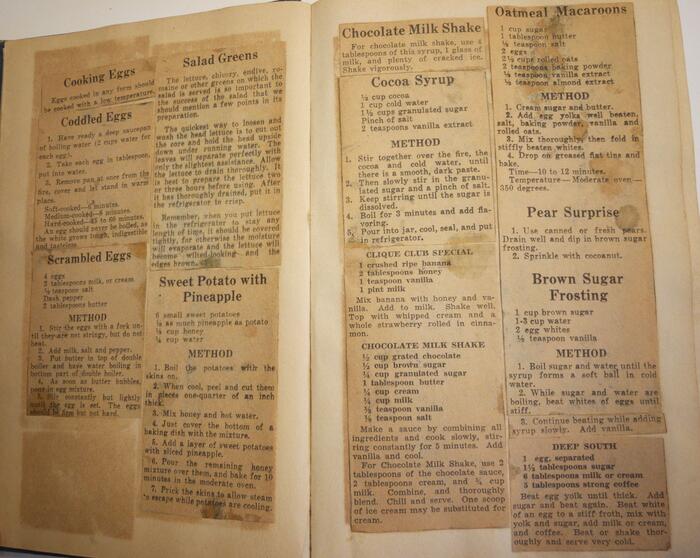A Taste of Yidishkayt: An Annotated Guide to All Things Food-Related in the Center's Collections
Published on January 30, 2018.
Below is a tour of some of the Yiddish Book Center’s multimedia, multilingual resources on the topic of food, starting with an exploration of the Center’s Yiddish-language cookbooks. Many are bilingual or were later translated into English. The cookbooks have been categorized into thematic groupings: reference/general, women’s, commercial, and health/vegetarian.
Food-related items from the Center’s other digital collections follow. You will find highlights from the Center’s English-language magazine, Pakn Treger, episodes from our English-language podcast, The Shmooze, and Wexler Oral History Project interviews, which are in English, Yiddish, and other languages.
Mit a gutn apetit, zol aykh voyl bakumen, tam gan-eydn, un est gezunterheyt (bon appétit)!
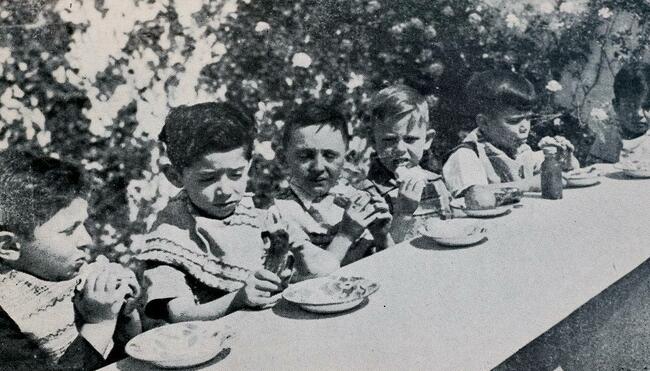
REFERENCE WORKS & GENERAL COOKBOOKS
Very few general cookbooks have reached us. It seems Ashkenazi cooking traditions were passed down orally, via other languages, and/or in other formats (e.g., periodicals).
1. Dos familyen kokh-bukh: bearbeytet nokh Amerikanishe, Frantsoyzishe, Italyenishe un Daytshe kokh-bikher spetsyel far der Yidisher kikh (The family cook-book: in the style of American, French, Italian and German cook-books specially for the Jewish kitchen) / H. Braun
- New York 1914
- New York 1928
- English translation (2010) (just cover and description; not full-text)
- Translator’s oral history interview
- Language(s): Advertised as bilingual; 363 pages in Yiddish; 26 pages in English
- Length: 389 pages; 694 recipes (in Yiddish)
- Yiddish recipes: Appetizers – meatless soups – sauces for meat – fish – meat – Passover – salads – sandwiches – pasta – rice – eggs – bread – pastries – vegetables – fruit – custards – junket – preserves – pickled – cooking for the sick – coffee and tea etc. – ice cream etc. – candies
- English recipes: Soups – milk soups – cheap soups – fish – meat – vegetables – pies, puddings, sweet dishes – original Jewish dishes
- Additional contents: Yiddish-language foreword describes the aim of the cookbook – Information on Koshering in English supplement from Alexander Harkavy
2. Yidishe makholim: a shtudye in kultur-geshikhte un shprakh-forshung (Food and beverages: a study in history of culture and linguistics) / Mordecai Kosover
- New York 1958 – published in Yuda A. Yofe-bukh (Judah A. Joffe book)
- New York 1958 – published separately (reprinted from Judah A. Joffe book)
- Language(s): Yiddish; footnotes and citations contain various languages
- Length: 302 pages (Judah A. Joffe book); 145 pages in separate publication
- Contents: Introduction – Foods from flour – The “five types of grains” in old-Yiddish sources – Foods from grains in Ashkenaz, Poland, Germany-Holland, Lithuania-Belarus and Slovakia – Cooked foods from flour, baby food, gruel, soup – Bread, “bread of heathens”, types of bread – Noodles, kreplekh, omelets – Meat pies and fruit layer cakes – Sponge cakes, tarts, ceremonial cakes, holiday loaves, mandlbroyt, marzipan, teyglekh – Rolls, challah, cookies, bagel, biscuit – Crepes, pancakes, blini, blintses, pierogies, knishes – Croutons, soup nuts, egg or dough in broth, kneydlekh, farfl
- Description from Eve Jochnowitz: “It’s about foods upon which one makes the brokhe ‘mezonos.’ Jewish foods that are made from flour, but are not bread”—“His primary sources are rabbinical responsa in which these lexical items turn up. As it happens, this category of mezonos does contain many of the Jewish foods that people are most interested in and curious about: blintzes, bagels, pierogn, kugels, lokshn, things like that. He finds the earliest known citations for these foods; it’s the O.E.D. of Jewish food.” (Eve Jochnowitz is currently working on translating this book.)
- Note: This one is not actually a cookbook, but is a seminal work on the topic of Yiddish/Ashkenazi cuisine, culture, and language.
Although women were the intended audience of most Yiddish cookbooks, some cookbooks made that fact more explicit than others. Find below our oldest cookbook from 1896 Vilna and a cookbook from 1930 New York embedded in a women’s handbook.
3. Kokh bukh far Yudishe froyen (Cook book for Jewish women) / O. Bloshteyn
- Vilna 1896
- Language(s): Yiddish; some words/expressions also rendered in German and/or Russian
- Length: 216 pages; 668 recipes/cooking tips
- Illustrations: Cover art and a diagram
- Recipes: Meat soups – soups without fat – dairy soups – sauces – fish dishes – cold dishes – roasts, stews, meat, poultry, various dishes – cow and sheep dishes – poultry dishes – vegetables and fruits of the earth – tree fruits – mushrooms – cereals – flour foods – dumplings – mixed grains – puddings – eggs and fried dishes – cakes and baked goods – pierogies – meat pies – strudels – other baked goods – sugary baked goods – compotes and salads – salads – kissel – jellies, jams, varenyes – creams – ice cream – preserves, pickled, marinated (over a long time) – Shabes – Passover – warm drinks – cold drinks – assembling meals
- Note: Unlike the other cookbooks listed here, this one was authored by a prolific writer of fiction. Much of Bloshteyn’s oeuvre fell in the romance genre and was often considered shund (trash) literature by critics. But judge for yourself: some of his other titles are available here.
4. Der froys handbukh: der praktisher kokh-bukh (The woman’s handbook: the practical cook-book) / Adella Kean Zametkin
- New York 1930
- Language(s): Yiddish
- Length: 648 pages total; pages 471-648 cookbook section (177 pages)
- Illustrations: Some illustrations in handbook; none in cookbook section
- Recipes: Meat dishes – fish dishes – egg dishes – custards – cheese dishes – vegetables – salads – salad dressings – sauces – tsimmes and baked apple – soups – bread and challah – coffee pastries – muffins – cakes – frosting and fillings for cakes – fillings for pies and cakes – cookies and other sweet morsels – scalloped foods – soufflés – croquettes – fritters – latkes and pletslekh – toast and sandwiches – seasoned cheese and butter – broths – cooked kashes – preserves – pickled things – jams – marmalades – conserves – gelatin – ice cream – candy – drinks
- Additional contents: Introduction at the start of cookbook on general observations, health, and which fats to use – introductory information at the beginning of major sections (e.g., fish, meat etc.).
Our largest category of cookbooks consists of publications from various American corporations in the food industry, as part of their marketing strategies.
5. Vashboyrn-Krosbi's Gold medal kokh-bukh (Washburn-Crosby’s Gold Medal cook-book) / Gold Medal Flour
- Minneapolis, Minnesota 1921 – available online through Harvard Library here
- Language(s): Yiddish
- Length: 70 pages
- Illustrations: Contains some color illustrations/advertisements
- Recipes: Soups – meat soups – dairy soups – trimmings for soup – meats – sheep meat – calf meat – chicken and poultry – cooked minced meat – fish – meat and fish sauces – eggs – fried dishes – cheese dishes – salads – salad dressing – cooked vegetables and legumes – white bread – plain and sweet rolls – cakes, pies, cookies – trimmings and fillings for cakes – kugels and kugel sauces – creams and custards – jellies and juices – pickles and ketchups – ice cream
- Additional contents: Foreword and information on measurements and weights.
6. Ba’tam’te Yidishe Makholim (Tempting Kosher Dishes) / Manischewitz
- Cincinnati 1928 (2nd edition)
- Cincinnati 1930 (3rd edition)
- Jersey City 1944 (5th edition)
- Jersey City, 1949 (6th edition)
- Language(s): Bilingual Yiddish and English
- Length: 77-158 pages and 112-250 recipes depending upon the edition
- Illustrations: All editions contain some color illustrations/advertisements, or even inserts
- Recipes: Appetizers – breads – cakes – cheese dishes – chicken and meat dishes – chremsels and fritters – cookies – candy – doughnuts and crullers – fish – knoedel – matzo and egg dishes – noodles – pancakes and waffles – pastry – puddings – vegetable dishes – miscellaneous
- Additional contents: Calendar of Jewish holidays.
7. Rokeyah Kokh Bukh (Rokeach Cook Book) / Rokeach Kosher Household Products
- Brooklyn 1933
- Length: 96 pages
- Language(s): Bilingual Yiddish and English
- Illustrations: Contains some black and white illustrations/advertisements
- Recipes: Entrees – soups – fish – meat dishes – vegetable dishes – puddings and desserts – sauces – salad dressings – cakes, cookies, pies, frostings, icings – miscellaneous dishes – Passover dishes
- Additional contents: Calendar of Jewish holidays – laws concerning salting of meat – weights and measures.
8. Krisko resepyes far der idisher baleboste (Crisco recipes for the Jewish housewife); Idishe resipis far gute Idishe gerikhten (Jewish recipes for good Jewish cooking) / Crisco
- Cincinnati 1933
- Cincinnati 1935
- Cincinnati 1940
- Oral history excerpt about Crisco cookbook
- Language(s): Bilingual Yiddish and English
- Length: 77 pages
- Illustrations: Contains some black and white illustrations/advertisements
- Recipes: Soups – main dishes – noodles, pancakes, dumplings – desserts – cookies – breads – cakes.
9. Reytsende gerikhten (Tempting dishes) / Wolff's Buckwheat Products
- Pen Yan, NY 1946
- Pen Yan, NY 1948
- Language(s): Bilingual Yiddish and English
- Length: 48 pages
- Illustrations: Not illustrated, but has colorful cover
- Recipes: Dishes of Wolff’s creamy kernels/buckwheat grits (includes puddings, kugels, pancakes, cutlets, soups, knishes, stuffed cabbage, stuffed beef steak etc.) – dishes of Wolff’s brown buckwheat groats (includes varnishkes, blintzes, knishes, tcholent, varenikes, cutlets, strudel, pudding, rolled cabbage, cereal soup, jelly layer cake etc.)
- Additional contents: Abridged 5-year calendar of Jewish holidays – weights and measures – baking – Wolff’s brown buckwheat groats – Wolff’s creamy kernels – Wolff’s pearled barley.
10. 46 oyfanim far besere Peyseh maykholim (46 ways to better Passover meals); 70 ofanim far besere Pesah maʼakhalim (70 ways to better Passover meals) / Planters Edible Oil Company
- Suffolk, VA [1940s]
- Suffolk, VA [1950s]
- Language(s): Bilingual Yiddish and English
- Length: 20-32 pages depending upon the edition
- Illustrations: Some black and white illustrations/advertisements (later edition)
- Recipes: Tasty meat recipes – recipes for knoedlach, chremsel, latkes, knishes – recipes for noodles and fritters – recipes for gravy and dressing – recipes for cookies, beolas, macaroons – recipes for pies, puddings etc. – recipes for cookies, crullers etc. – recipes for Passover salads – recipes for pies, pudding, fillings – recipes for carrot tzimmes, matzo koese, potato kugel – a tasty liver recipe – recipes for salad dressings – recipes for cookies and cake.
Find below our newest cookbook from 1990, two vegetarian cookbooks from the 20s and 30s, and a new English translation of a Yiddish vegetarian cookbook from 1938 Vilna.
11. Kokh-bukh far gezuntheyt (Cook-book for health) / Lena Brown
- New York 1931
- Language(s): Yiddish
- Length: 94 pages
- Recipes: Salad dressings – how to prepare raw salads – stuffed pepper salad – fruit salads – how to cook vegetables – how to make soup – latkes, puddings, knishes – pies, cakes and cookies – doughs, preserves and candy – drinks – how to make sandwiches – how to cook eggs
- Additional contents: Foreword – natural healing – chemical elements in humans – human body – how food is used by the body – vitamins – daily calorie intake – signs of a healthy person – what is health and sickness? – indigestion – colds – low blood pressure – high blood pressure – thin people – overweight people – pregnant women – sleep – commandments for health – morning nutrition – preparing three meals a day – the five senses – the skin – teeth – hair – nails – gymnastics – bathing – nutrition – the kitchen.
12. Vegetarishe kokh bukh (Vegetarian cook book) / A. B. Mishulow and Mrs. Shifrah Y. Mishulow
- New York 1926 – Vegetarian cookbook with Gezunt un shpayz (Health and nutrition)
- New York 1926 – Vegetarian cookbook published separately
- Language(s): Yiddish
- Length: 203 pages; 474 recipes (health and nutrition guide is an additional 193 pages)
- Illustrations: Contains black and white illustrations (and advertisements)
- Recipes: Salad (introduction, sauces/dressings, salad from garden greens/fruit/nuts, hors d’oeuvres and appetizers, soup, soufflé, vegetables) – roasts, cutlets and croquettes (introduction, sauces, dairy courses, kashes and cereals, toasts, sandwiches, egg courses, snacks and desserts, sugar pastries, drinks) – bread and other baked goods
- Additional contents: Poem about vegetarianism – foreword – words to the reader – cooking and nutrition – garden greens, plants, and fruit – weights and measurements – the kitchen and cooking utensils/appliances – nutrition cards (menus) for every day.
13. Maykholim tsum gezunt (Food for health cookbook) / Malky Eisenberger
- Brooklyn 1990
- Brooklyn 1991 – translated into English by the author
- Language(s): Yiddish; some terms/expressions in English
- Length: 239 pages; 100 recipes
- Recipes: Cooking with grains – soup – baking with whole wheat flour – pickled side dishes – miscellaneous – Shabes – drinks – home remedies (green clay, tea)
- Additional contents: Science section (introduction, digestion, water, protein, grains, plants, milk, oil, sugar, salt, spices, greens, nuts, sprouts)
- Description from Eve Jochnowitz: “Mokholim tsum gezunt, written and published in 1990 in Yiddish by a Hasidic woman primarily for Hasidic women, is a macrobiotic almost vegetarian, mostly vegan cookbook”—“Like the household manuals of the last century, Mokholim tsum gezunt and Food for health combine recipes with remedies and homemaking secrets. Mrs. Eisenberger tells how to get static out of a child's hair (rub a drop of olive oil into the bristles of the hairbrush), how to keep your feet warm (sprinkle a bit of cayenne pepper in shoes), and how to care for a wig (style with sugar water).”
14. The Vilna Vegetarian Cookbook / Fania Lewando; Translated from the Yiddish, annotated, and adapted for the modern kitchen by Eve Jochnowitz
- English Translation (New York 2015) – originally published in Vilna in 1938
- Podcast with Eve Jochnowitz
- Eve Jochnowitz’s oral history interviews from 2016 and from 2010
- Language(s): English; translated from Yiddish
- Length: 234 pages
- Illustrations: Contains color illustrations from the original Yiddish cookbook and photographs of Fania Lewando and her restaurant in Vilna
- Recipes: Salads – soups – cutlets – stewed dishes – miscellaneous dishes – blintzes – omelets – porridges – frittatas – kugels with cholents – puddings – latkes – Passover foods – substantial puddings – sauces and creams – stuffed foods – baked goods – jams and preserves – turnovers – compotes and desserts – glazes and garnishes for cakes – coffee, buttermilk, and yogurt – marinated foods – ices – wine, mead, and liqueur – vitamin drinks and juices
- Additional contents: Foreword – translator’s preface – Fania Lewando – to the housewife – why are fruits and vegetables so important for the organism? – vegetarianism as a Jewish movement – vitamins – excerpts from the guest book in Fania Lewando’s Vegetarian-Dietetic Restaurant – biographical sketches from the guest book
- Note: The Center does not hold the original Yiddish-language cookbook, which may be viewed through YIVO. Other English-language cookbooks available for purchase at the Yiddish Book Center can be viewed here, including Recipes Remembered, which includes stories and recipes from Holocaust survivors.
PERIODICALS & ARCHIVAL MATERIALS WITH RECIPES
In addition to our cookbooks, we have received numerous Yiddish recipes through our many periodicals, as well as others, which arrived crumpled in a paper bag or neatly arranged in a small box. In this From the Vault article, Mikhl Yashinsky writes about encountering the Center’s stash of archival recipes, trying out a few of them, and then tracking down their provenance.
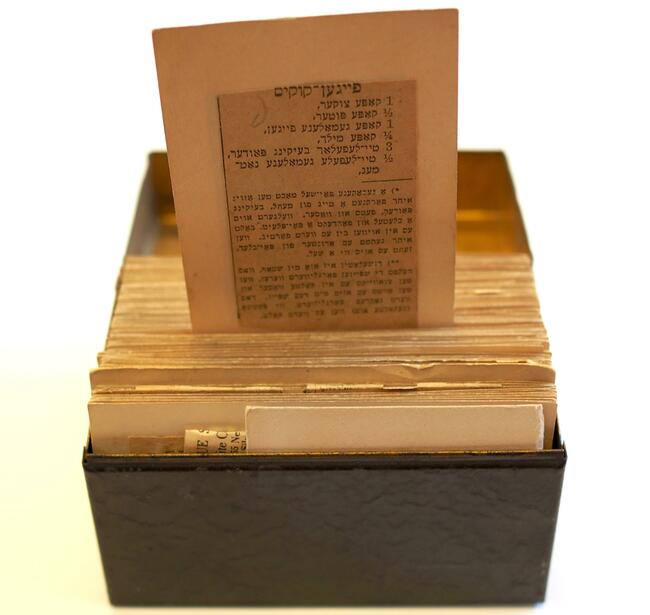
PAKN TREGER ARTICLES ABOUT FOOD
The Fall 2017 Pakn Treger issue includes a description of teiglech, and the recipe has been made available on the Center’s website. The 67th Pakn Treger from summer 2013 is “the food issue,” with articles on New York delis and Jewish food purveyors. From the column “Well said,” a few articles focused on food expressions, including those about kosher and treyf, baked goods, cholent, and gefilte fish. An exploration of Yiddish culture and literary cafes can be found here. This translation of Yenta Mash’s A Seder in the Taiga, describes a Passover meal amongst women prisoners in a Soviet gulag.
The Center’s English-language podcast The Shmooze features several food related discussions. In this podcast, culinary anthropologist Eve Jochnowitz speaks about translating Fania Lewando’s Yiddish-language vegetarian cookbook from 1938 Vilna. Molly Yeh discusses her new cookbook with recipes inspired by her Jewish, Chinese roots. Award-winning cookbook author Joan Nathan speaks about her cookbook King Solomon’s Table: A Culinary Exploration of Jewish Cooking from around the World. Shannon Sarna, editor of the Jewish food blog “The Nosher,” discusses her new cookbook Modern Jewish Baker: Challah, Babka, Bagels & more. Other topics include making the perfect latke, how coke became kosher, a new take on gefilte fish, eating Delancey, the pop-up Jewish dinner club, and reimagining matzo.
ORAL HISTORY INTERVIEWS ABOUT FOOD
A simple search for “food” leads to 200+ oral history excerpts and 100+ full-length interviews. Eve Jochnowitz, scholar of Jewish culinary history and translator, talks about how language and food weave through the tapestry of daily life. In these excerpts about cookbooks, Bracha Weingrod explains why she translated Di familyen kokh-bukh and Annette Epstein Jolles discusses her copy of the bilingual Crisco cookbook. Cara de Silva speaks about her experience editing a book of recipes written down by women in the Terezín (Thereisenstadt) concentration camp. Many excerpts focus on specific recipes and foods, such as Albert Berkowitz’s memories of Romanian eggplant salata, Alice Ahart’s tip-toe recipe for sponge cake, or Clare Burson’s description of papa’s 100+-year-old wedge of cheese. Thelma Oldak Finkler speaks about the conflict between Russian and Polish culinary traditions in her family kitchen, how Mexican cuisine later entered the mix, and she even shows the board and roller her family brought from Russia. Marina Vaysman explains how in Soviet Ukraine her grandmother continued to cook Jewish foods for the family and how she gave Marina a cooking lesson, telling her, “you watch me just like I watched my mother and that’s how you learn.”

